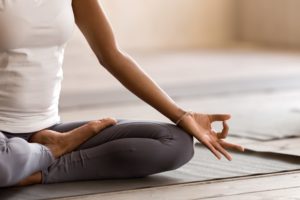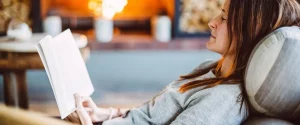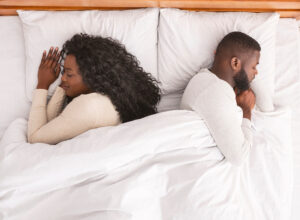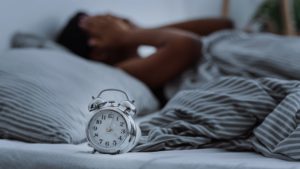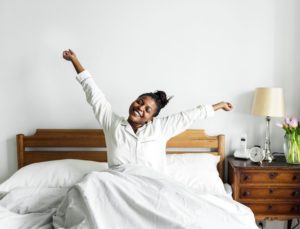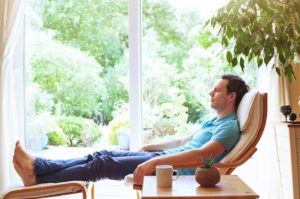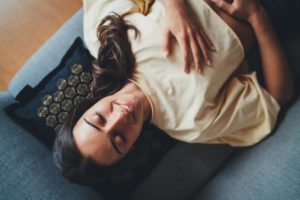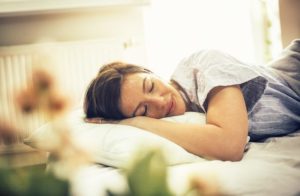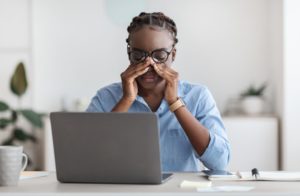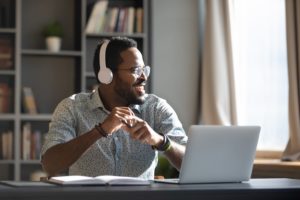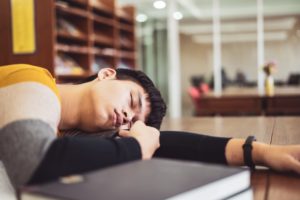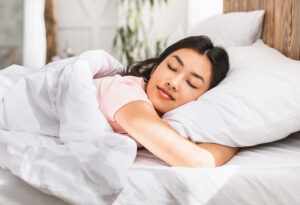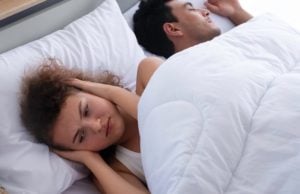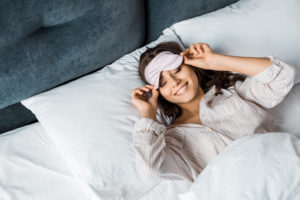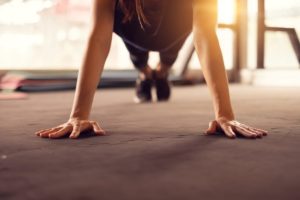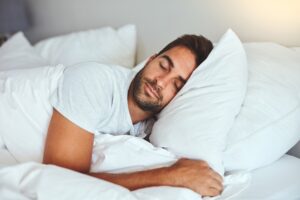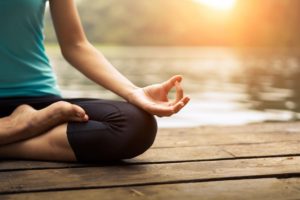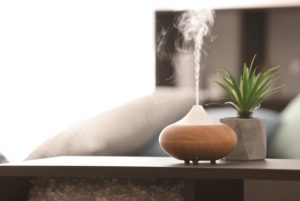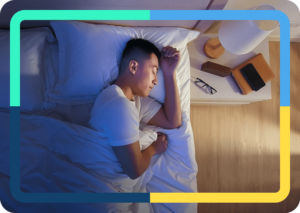Stretching Before Bed
Since stress relief is important to get quality sleep, sleep experts recommend developing a routine in the evening to wind down from the day. Some people may benefit from quiet activities such as reading or taking a warm bath. Others may find stress relief through gentle stretching before bedtime.
Stretching is a natural, effective strategy for relaxing the muscles. Stretching not only helps maintain physical health but also supports mental health and relieves stress. Practices such as yoga, tai chi, or qi gong involve stretching along with focused breathing and mindfulness to achieve calm.
Doing these activities or other forms of stretching before bedtime can alleviate stress and make it easier to fall asleep and may improve sleep quality . We walk through several stretches that can be done slowly and gently in the evening to help you unwind before bedtime.
Are You Getting Enough Deep Sleep?
A variety of issues can cause degrade your sleep quality. Answer three questions to understand if it’s a concern you should worry about.
Neck Stretches
Many daytime activities can cause neck strain or tension . For example, bending over a desk or looking at a computer at an incorrect height puts stress on the neck. Performing neck stretches before bed can relieve excess tension and avoid potential discomfort during sleep.
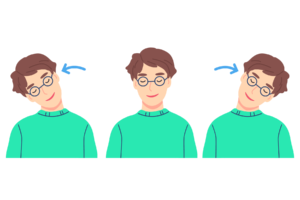
Ear to Shoulder Neck Stretch
- Sit in a comfortable chair or stand.
- Gently bring your right ear towards your right shoulder until you feel the stretch.
- Maintain the stretched position for 5 to 10 seconds.
- Slowly lift your head back to your starting position.
- Repeat the stretch on the left side.
- Repeat two to four times.
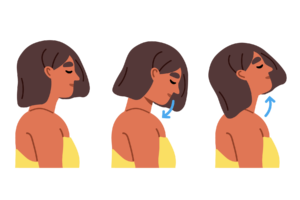
Up and Down Neck Stretch
- Sit in a comfortable chair or stand.
- Gently lower your chin toward your chest.
- Press your chin into your neck for 15 to 30 seconds.
- Slowly raise your head back to your starting position.
- Raise your chin toward the ceiling and hold the position for 5 to 10 seconds.
- Slowly lower your head back to your starting position.
- Repeat two to four times.
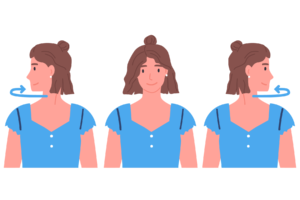
Side to Side Neck Stretch
- Sit in a comfortable chair or stand.
- Gently turn your head to the right until you feel the stretch.
- Maintain the stretched position for 5 to 10 seconds.
- Slowly turn your head back to your starting position.
- Repeat the stretch on the left side.
- Repeat two to four times.
Shoulder Stretch
Throughout the workday, sitting with poor posture can cause pain in the shoulders. You can slowly shrug your shoulders before bedtime to relieve some of the built-up tension.
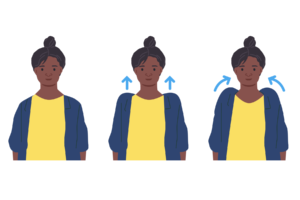
Shoulder Stretch
- Raise your shoulders to your ears.
- Hold the position for three seconds.
- Roll your shoulders back.
- Lower your shoulders back to your starting position.
- Repeat the stretch 10 times.
Back Stretches
In addition to neck and shoulder pain, poor posture can cause pain in the back. Stretching can relieve or help prevent this back pain. Reducing back pain and relaxing the back muscles may be a helpful part of unwinding at night.
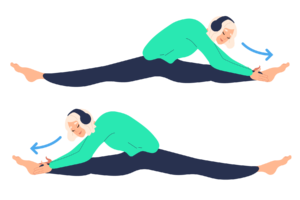
Seated Lower Back Stretch
- Sit on the floor with legs spread as far apart as is comfortable with your knees straight but not locked.
- Rest both hands on top of your right knee.
- Slowly reach your hands toward your right ankle.
- Hold the stretch at a position that feels comfortable to hold for 10 seconds.
- Slowly return to your starting position.
- Repeat the stretch on the left side.
- Repeat the stretch 10 times per leg.
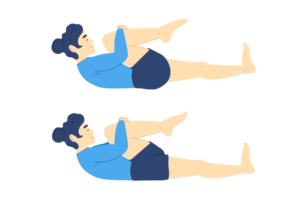
Reclined Lower Back Stretch
- Lie on your back on a flat surface.
- Place both hands behind your right knee.
- Bring your right knee to your chest and hold the stretch for 10 seconds.
- Slowly return your leg to your starting position.
- Repeat the stretch with your left knee.
- Repeat 10 times.
Overhead Stretch
An overhead stretch involves muscles in the upper body, shoulders, and arms. The stretch incorporates deep breathing, which makes it great for relaxing before bedtime.
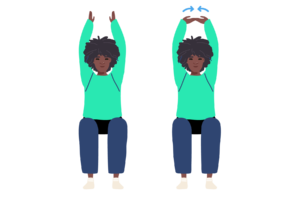
Overhead Stretch
- Sit in a comfortable chair or stand with feet shoulder-width apart.
- Bring both hands over your head and interlace your fingers stretching toward the ceiling.
- Inhale deeply and suck in your stomach.
- Hold the position for a few seconds.
- Exhale as you bring your arms down.
Leg Stretches
Some people experience cramps in the legs in the evening or at night time . Leg stretches before bedtime can relieve leg cramps and tension. There are many muscle groups in the legs you can stretch.
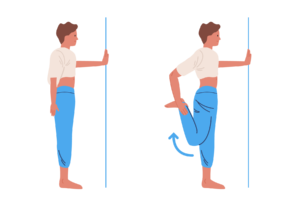
Standing Quadricep and Thigh Stretch
- Choose a location with an object or surface you can comfortably hold for balance.
- Stand on the right leg and grasp the left foot. Keep the left knee pointed toward the floor.
- Pull the left foot back gently toward the buttocks until you feel the stretch in the front of the left thigh.
- Hold the stretch for up to 20 seconds.
- Repeat the stretch with the right foot.
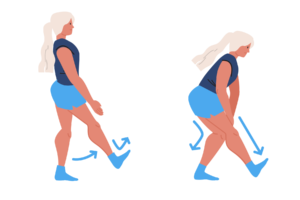
Hamstring Stretch
- From a standing position, extend the right leg forward keeping the foot flexed.
- Bend the left knee and lean back a little.
- Keep the pelvis forward and body upright.
- Hold the position for up to 20 seconds.
- Perform the stretch on the left side.
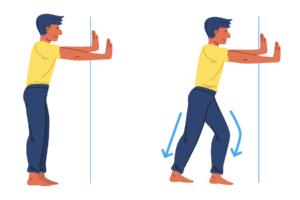
Calf Stretch
- Start in a standing position facing a wall.
- Take a step forward with the right foot and bend the right knee.
- Keep the left leg straight.
- Brace your hands against the wall for support keeping the heels of both feet on the floor.
- Bend the right knee until you feel a stretch along your left calf. For a deeper stretch, bend the knee more.
- Hold the stretch for up to 30 seconds.
- Repeat the stretch with the left foot forward and left knee bent.
- Repeat the stretch four to five times on each leg.

Yoga Poses for Relaxation
Yoga is a popular practice that can help people relax , improve sleep , reduce stress, and alleviate neck and back pain. Some people incorporate yoga into their sleep hygiene routine as a way to unwind and stretch before bed.
Child’s Pose
Child’s pose or balasana is a calming yoga pose. The stretch releases shoulder tension as well as tension in the facial muscles.
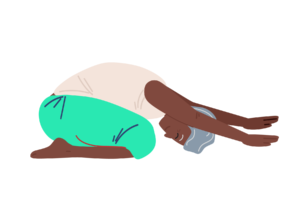
- Kneel on the floor with your arms at your sides.
- Knees should be hip-width apart while you gently shift your weight back so that the buttocks move toward your feet.
- Stretch the arms long behind the body and place your hands palm-up on the floor.
- Sink your chest to the floor letting it rest on your thighs.
- Put your forehead down on the ground.
- Close your eyes and take steady deep breaths.
Cat and Cow Pose
Cat pose and cow pose, or marjayasana and bitilasana, are related positions that relieve tensions in the neck, shoulders, and back such as those caused by sitting at a computer during the day. You can try slowly transitioning back and forth between cat pose and cow pose for a gentle stretch.
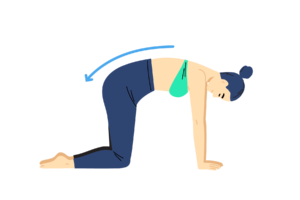
- Begin by kneeling on the floor. Reach your hands forward, ahead of your shoulders keeping them shoulder-width apart.
- Press down on your hands.
- Slowly arch your back upwards as your head falls down between your shoulders.
- Continue to arch the back while drawing the stomach in.
- Slowly lower your back to return the spine to a neutral position.
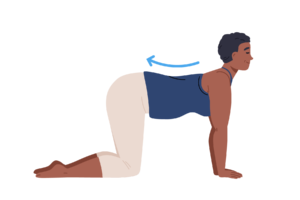
- Begin by kneeling on the floor. Reach your hands forward, ahead of your shoulders keeping them shoulder-width apart.
- Press down on your hands.
- Slowly roll the shoulders up and back and lower the stomach, creating a scoop in the spine.
- As the spine scoops, the neck and head come up, stretching the front of the neck.
- Slowly raise your back to return the spine to a neutral position.
Savasana
Savasana, also called corpse pose, is often the final pose of yoga activity. The pose helps the entire body relax and can be done with the eyes closed, making it a good choice to end your bedtime stretch routine with.
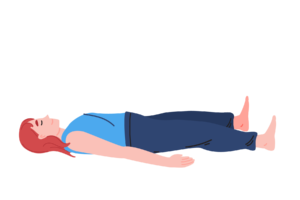
- Lay on a flat surface.
- As you inhale, bring your knees to your chest.
- As you exhale, stretch your legs away. Let them lower to the floor.
- Relax your shoulders by drawing them away from your ears.
- Let your arms rest at your sides with your palms up.
Frequently Asked Questions About Stretching
While breathing techniques during stretching vary, the most important thing to remember is to continue breathing. You can try different breathing practices while stretching to see what feels most comfortable to you. Some yoga practitioners recommend breathing in and out through the nose.
In addition to stretching, some people may enjoy deep breathing as a relaxation technique before bedtime. Inhale until you feel your stomach lift, then hold your breath for a moment before exhaling.
About an hour before bed, you can begin your nightly bedtime routine that may include various relaxation practices such as stretching, yoga, or other meditative practices.
Dynamic stretches may not be helpful for relaxation before bedtime. Dynamic stretches move the body in a range of motion, such as in aerobic dance and calisthenics. Such exercise may increase the heart rate and therefore should be avoided two hours before bedtime.
Instead, consider performing static stretches before bed. Static stretches, such as yoga, involve holding specific positions for a period of time.
Before performing stretches that involve injured parts of your body, consult a health care provider, such as a physical therapist. They can advise which stretches are appropriate for your specific injury and which stretches to avoid until you are recovered.
Most stretches can be held between 10 and 30 seconds. Slight discomfort during a stretch is common but stretching should not feel painful. If you have questions about stretching, talk with your health care provider.

Still have questions? Ask our community!
Join our Sleep Care Community — a trusted hub of sleep health professionals, product specialists, and people just like you. Whether you need expert sleep advice for your insomnia or you’re searching for the perfect mattress, we’ve got you covered. Get personalized guidance from the experts who know sleep best.
References
9 Sources
-
Johnston, B. D. (2021, June). Overview of exercise. Merck Manual Professional Version. Retrieved August 10, 2022, from, Retrieved August 10, 2022, from
https://www.merckmanuals.com/professional/special-subjects/exercise/overview-of-exercise -
Wang, F., Eun-Kyoung Lee, O., Feng, F., Vitiello, M. V., Wang, W., Benson, H., Fricchione, G. L., & Denninger, J. W. (2016). The effect of meditative movement on sleep quality: A systematic review. Sleep Medicine Reviews, 30, 43–52.
https://pubmed.ncbi.nlm.nih.gov/26802824/ -
A.D.A.M. Medical Encyclopedia. (2022, April 1). Neck pain. MedlinePlus.
https://medlineplus.gov/ency/article/003025.htm -
American Council on Exercise. (n.d.). Neck exercises. Retrieved August 10, 2022, from, Retrieved August 10, 2022, from
https://www.acefitness.org/resources/everyone/exercise-library/body-part/neck/ -
MedlinePlus: National Library of Medicine (US). (2017, October 25). Guide to good posture.
https://medlineplus.gov/guidetogoodposture.html -
Albright, K. T., Lane, K, A.G., Leiby, L., Norris, C. G., Short, S. C., & Steigerwald, M. A. (2022, January). Quick facts: Low back pain. Merck Manual Consumer Version. Retrieved August 10, 2022, from, Retrieved August 10, 2022, from
https://www.merckmanuals.com/home/quick-facts-bone,-joint,-and-muscle-disorders/neck-and-low-back-pain/low-back-pain -
MedlinePlus: National Library of Medicine (US). (2020, August 13). Muscle cramps. Retrieved August 10, 2022, from, Retrieved August 10, 2022, from
https://medlineplus.gov/musclecramps.html -
A.D.A.M. Medical Encyclopedia. (2020, August 13). Yoga for health. MedlinePlus. Retrieved August 15, 2022., Retrieved August 15, 2022.
https://medlineplus.gov/ency/patientinstructions/000876.htm -
National Center for Complementary and Integrative Health. (2019, May). Yoga: What You Need To Know.
https://www.nccih.nih.gov/health/yoga-what-you-need-to-know









